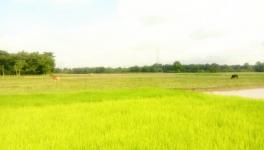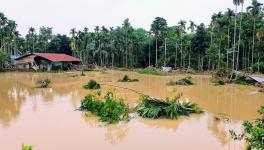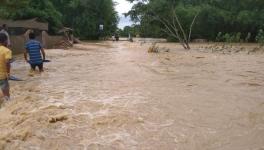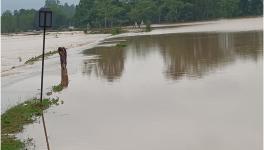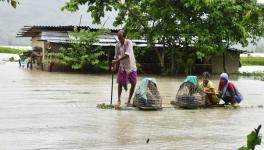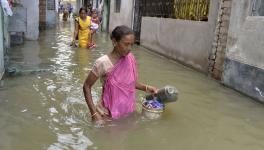Assam: Floods Gone, But People Continue to Suffer with Insufficient Aid

There were some houses, and the flood washed them away within hours. Deobali, Raha, Nagaon (Assam).
“What will we do? Our houses and other belongings were washed away by the floods. We cannot repair our houses, nor we can do any harvesting this year. Will we be able to do so next year?”— the flood-affected people of Assam are deeply pained with such weighty questions in their mind. By now, the floods have receded, at least for this year and as usual, an eerie silence pervades the atmosphere. Government aid declared at the time of the floods, when the chief minister was seen visiting the affected areas, is not visible anywhere now. And for the affected people, there are more questions looming on their future that the aids and perks alone seem insufficient to address.
THE BACKGROUND
Imagine a situation when the water comes gushing in and within a few hours, the house collapses, sometimes partially and sometimes entirely with all the belongings washed away. People in Assam have had to face such horrors in floods, an annual catastrophe, with varying degrees of devastation. The water current is so strong that it leaves no time to prepare and save even the tiniest of belongings; the only option that remains is to run away, leaving everything behind.
And what about the paddy fields washed by the waves of water? Paddy seedlings are destroyed before they can be planted, and even worse is when fields are filled with sand at several places—all unfit for cultivation of rice, the staple food of the state. In addition, farmers are apprehensive about whether they will be able to continue farming even in the absence of a massive flood next year since huge swathes of paddy fields have a substantial amount of sand deposition which can hamper cultivability.
For Assam, this year was a torment for many. First, two spells of massive floods at an interval of a month in May and June, then a prolonged dry spell spurred a drought-like situation in several places. Torrential rains and concomitant floods at the time of planting paddy seedlings destroyed them totally, and followed a long dry spell when water was needed in plenty. All this left farmers hopeles. Newsclick covered Assam’s floods in its previous ground reports.
NAGAON: THE DILAPIDATED REGION
The district of Nagaon, in the middle of the state, was the worse sufferer. Especially the Raha and Kampur regions witnessed the severest of flood conditions, with other parts having moderate impact. During May and June, travelling up from Guwahati toward Nagaon, one could see huge paddy fields on either side of the National Highway submerged in water. In some places, the NH narrowly escaped from being completely submerged. Experts from Assam raised the issue while the NH was being converted to a four-lane one. They opined that this activity may result in worsening of the flood situations in future. This was based on two observations—first, the NH contained inadequate openings through which water drainage can take place from beneath the NH, and second, the four-lane became higher than the previous NH, for which land was dug from the sides of the fields.
Raha is over 100 kilometres from Guwahati, the state capital, and one needs to deviate from the NH for around 10-15 km to reach the worst-affected areas of Raha and Phuloguri in Nagaon district. Durgajan, Majgaon, and part of Dighaldari are adjacent villages situated on the banks of Kolong river with the ‘Kolongbank’ embankment separating the villages from the river. The Kolongbank embankment is a long, narrow stretch touching many other villages and is in motorable condition. This embankment was breached at several places during the floods creating havoc for the villagers.

Walking on the Kolongbank embankment with Kolong river on one side and villages on the other. The flood breached the embankment destroying houses. People mended it temporarily with bamboo bridges.
NewsClick reached the house of Satyajit Das of Durgajan village, who lost half of his house during the flood. His family is managing in the remaining rooms that are in dangerous condition with cracks in the walls that can collapse even during a low-scale earthquake.
A flood damaged house.
Not only Das, but others in Durgajan and nearby villages also live in the same situation. “The house was a dream for our family, it took blood, sweat and tears of my husband and my son to build the house. And now it has gone, our hopes are shattered. My son is no government employee; he depends on agriculture and his own labour and skills to earn a livelihood. He went mad seeing the house collapse at midnight on 19th or 20th June,” said Aikoni Das, a resident of Majgaon village. “Moreover the little agricultural land we possess, we fear, will not be so easily cultivable due to sand deposition. We could not save any paddy seedlings and will not have any harvest,” she added.
One can understand how desperate the people are to get some more relief so that their houses can be repaired, and their lives become as earlier. While the NewsClick team was in conversation with the villagers, other people started pouring in. They thought some government officials had arrived for surveying or provide some aid. Knowing that it is a media team, they spoke their hearts out. A similar experience awaited us in other affected areas, too.
Flood devastated houses of Durgajan, Majgaon and other villages in Raha and Nagaon of Assam.
Didn’t people receive any aid or compensation from the government or any other agency? What about the lofty declarations made at the time of the floods? Were the proactive deeds of the chief minister a mere media gimmick?
It’s worth remembering here that Assam CM Himanta Biswa Sarma declared a grant of Rs. 95,000 for each family whose houses (pucca) were completely damaged. Moreover, a flurry of other packages were also promised by the state government.
Lakhimoni Das of Majgaon said only a few families had received the grant of Rs. 95,000. She said government officials visited their areas to take a survey for disbursement of the grant and her family’s name was also there. But, they are yet to receive it. Even after several rounds of visits to the government offices concerned, compensation has not been received till date. Interestingly, the immediate grant of Rs 3,800 to the flood-affected people was received by none in their villages, as Lakhimoni Das and others told NewsClick.
According to Das, no less than 91 houses were severely damaged and among them, 14 were destroyed completely at Durgajan. Yet, not everyone has received the money. One woman narrated a peculiar problem. She said, “those who have accounts in SBI (State Bank of India) have received money, but the account holders of PNB (Punjab National Bank) have not. Our villagers have accounts in neither of these banks.”
The villagers echoed in unison that the grant of Rs 95,000 is grossly insufficient to rebuild a house. “Even to fill up the pit about 15 feet deep and even larger diameter, we will have to spend around Rs 50- 60,000. How can one expect to reconstruct a house with Rs 30-40,000?” asked Maikon Das of Majgaon village.
Das further said, “this year around 100 bighas of lands remained barren due to the floods. We remember the previous massive floods of 2004 and 1986. But, did not see the houses damaged by water as it happened this year. In 2004, people from the Mudoi Gaon (2.5 km away from Durgajan) fled from their original places.”
Sadhani Hazarika, Purobi Hazarika and Deeptimoni Das from Majgaon village had their own agonies to share. They reported receiving no grants yet; neither the relief of Rs 3,800 and Rs 3,200 nor the grant of Rs 95,000.
From Durgajan, travelling around 5km or so we arrived at the Jakarowa village. Here people from nearby villages of Udarbheti, Kajalajan, Ranga Gara etc. gathered to speak about their pain. People here also did not see a coherent system of disbursing aid. From the areas surveyed and eligible to receive a particular aid, only a few have got the amount, the rest are still waiting.
“We still remember the horror of June 19. Within one or two hours, gushing water submerged everything and in the middle of the night we had to arrange some boats, while the majority of people rushed to the shelter camps at Phulaguri and Dimou chariali, with water to the level of the chest,” said Rohini Das of Jakarowa village. He said only one-fourth of the affected people received the relief fund of Rs 3,800. “There are anomalies in other schemes as well—we could not receive anything positive to receive the crop insurance (Pradhan Mantri Fasal Bima Yojana). All our lands are barren,” he added.
Why are people suffering? Was it indeed a natural disaster that nobody had control over? People from these villages said that the release of water from the North Eastern Electric Power Corporation (NEEPCO) dams over the Kopili river that runs through Nagaon actually made the scenario worse, at least in destroying the houses. One villager from Jakarowa said: “Even the Gaonburha (the village head) announced before the water came in, that that the dam gates had been opened. We used to see the television to know when and how many gates have been opened.” The Kopili and the Karbi Langpi dams have released huge amounts of water that became so furious and strong, that it created huge pits and led to house collapses, many villagers told NewsClick.
From here on, we moved to Deobali at Raha itself. The photo below and the photo in the beginning of the article have been clicked from the same place but at a gap of three and a half months. The picture in the beginning was during the floods, in June and the photo below is in October. These photographs reveal how people continue to live amidst the debris of their damaged houses waiting for the collapse.

Deobali, Raha. The huge pond (over 50 feet deep) was created by the flood washing away some houses there. People continue to live amidst debris and broken homes.
Somnath Das of Deobali shared similar concerns of unclear aid and relief disbursal along with the insufficient amount received by a few.
Moving southward via Chaparmukh, NewsClick reached Kampur, another severely affected area of the Nagaon district. The road to Kampur runs through the bank of the Kopili river, which showed its ugly form during the flood. But, can all the blame be levied on Kopili alone?
Molan Laskar, a noted social worker in Kampur and a former journalist, explained to NewsClick how the dams actually impacted the degree of the flood. “The floods are not natural alone, they have a human contribution as well. The Khandong, Kopili, and Karbi Langpi dams have a great impact on the floods. The speed and the volume of water that could wash away a concrete house within minutes are not due to nature alone. There has to be a release of huge amounts of water from the dams situated uphill in Dima Hasao and Karbi Anglong, which came down to the plains with tremendous force and volume. During that period there were torrential rains in Assam and the rivers are anyway swamped. With the extra water from the dams, it becomes extra energetic to destroy anything that comes in front. There are also numerous dams being constructed in Arunachal Pradesh, Bhutan which may prove fatal for the people of Assam in future”.
At Kampur, NewsClick visited Atikampur village where an absurd scenario was revealed by villagers. They said that while many of the poor, whose kutcha (not concrete) houses were destroyed, have not received anything, not even Rs3,800, some people living in RCC buildings have received that amount.

Sonakali Laskar and his dilapidated house in the backdrop in Kampur, Nagaon.
Sonakali Laskar of Atikampur village said his kutcha house was completely damaged, but he did not receive any aid. There are also others like Bijon Laskar, Bhimon etc. in the same village who face the same fate. These people, for generations, have not been absorbed in any government job and daily wage labour is the only means of their survival. They also do not have enough land, and work in others’ fields and get some rice in return.
Moving further, NewsClick reached Palasa, another backward village on the bank of the Haria river. During floods, the entire village was submerged in water and it was almost empty. “Sometimes, when Kopili swamps it causes Haria to flow in the reverse direction and this brings in more water and more floods. This happened during the floods this year,” said Molan Laskar.
The Palasa village has mostly Bengali-origin residents with a majority being the Namasudras. People from Palasa also narrated the same woes—incoherency in the distribution of relief both during the floods and after. Mostly, these villagers are dependent on fishing in the Haria river along with daily wage labour and small-scale business. They also have little cultivable land in their possession and this year there is no scope for harvesting due to the floods.
Overall, the flood-affected people, both from Raha and Kampur, see their days passing on with uncertainties. The most reliable government relief that they receive is free rice (5 kilograms per person) under the Annapurna scheme and a meagre amount of Rs 1,200 per month under the Orunodoy Scheme (run by the Assam government). “We are surviving with the free rice that the government provides. If this is stopped, then we will have to starve, as we won’t have any rice to harvest and our granaries are already emptied by the floods,” said Deepak Biswas of Palasa.
*All the photographs used are taken by the author
Get the latest reports & analysis with people's perspective on Protests, movements & deep analytical videos, discussions of the current affairs in your Telegram app. Subscribe to NewsClick's Telegram channel & get Real-Time updates on stories, as they get published on our website.









